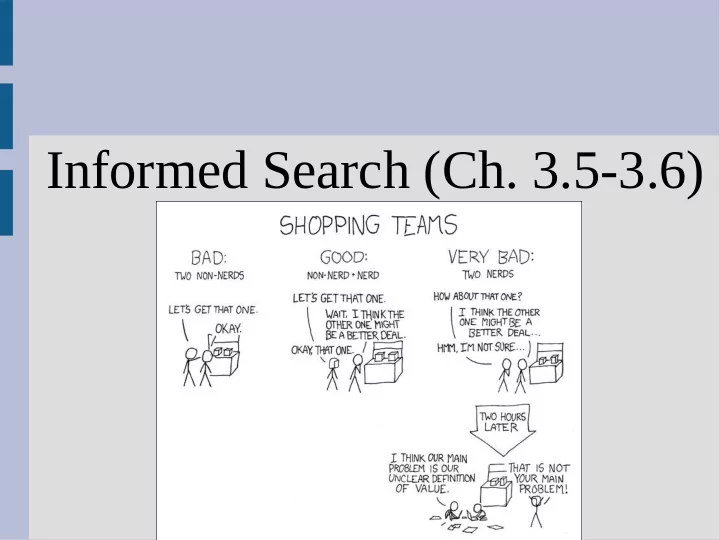

Informed Search (Ch. 3.5-3.6)
Announcements HW1 graded
Heuristics However, for A* to be optimal the heuristic h(node) needs to be... For trees: admissible which means: h(node) < optimal path from h to goal (i.e. h(node) is an underestimate of cost) For graphs: consistent which means: h(node) < cost(node to child) + h(child) (i.e. triangle inequality holds true) (i.e. along any path, f-cost increases)
A* Remember this? Not consistent (between S and B)
Heuristics Consistent heuristics are always admissible -Requirement: h(goal) = 0 Consistency is a strong requirement, so an admissible heuristics might not be consistent, but a consistent heuristic is always admissible A* is guaranteed to find optimal solution if the heuristic is admissible for trees (consistent for graphs)
Heuristics In our example, the h(node) was the straight line distance from node to goal This is an underestimate as physical roads cannot be shorter than this (it also satisfies the triangle inequality) Thus this heuristic is admissible (and consistent)
Relaxation The straight line cost works for distances in the physical world, do any others exist? One way to make heuristics is to relax the problem (i.e. simplify in a useful way) The optimal path cost in the relaxed problem can be a heuristic for the original problem (i.e. if we were not constrained to driving on roads, we could take the straight line path)
Relaxation Let us look at 8-puzzle heuristics: The rules of the game are: You can swap any square with the blank Relaxed rules: 1. Teleport any square to any destination 2. Move any square 1 space (overlapping ok)
Relaxation 1. Teleport any square to any destination Optimal path cost is the number of mismatched squares (blank included) 2. Move any square 1 space (overlapping ok) Optimal path cost is Manhattan distance for each square to goal summed up Which ones is better? (Note: these optimal solutions in relaxed need to be computed fast)
Heuristics & Branching Factor h1 = mismatch count h2 = number to goal difference sum
Heuristics & Branching Factor The real branching factor in the 8-puzzle: 2 if in a corner 3 if on a side 4 if in the center (Thus larger “8-puzzles” tend to 4) An effective branching factor finds the “average” branching factor of a tree (smaller branching = less searching)
Heuristics & Branching Factor The effective branching factor is defined as: ... where: N = the number of nodes (i.e. size of fringe + size of explored) b * = effective branching factor (to find) d = depth of solution No easy formula, but can approximate:
Heuristics & Branching Factor A* search then has the following properties: If b* is the effective branching factor: 1. Completeness: Complete 2. Optimality: Optimal (if tree & admissible or graph & consistent) 3. Time complexity: (b*) d (Note: b* < b) 4. Space compexity: (b*) d
Combining Heuristics h2 has a better branching factor than h1, and this is not a coincidence... h2(node) > h1(node) for all nodes, thus we say h2 dominates h1 (and will thus perform better) If there are multiple non-dominating heuristics: h1, h2... Then h* = max(h1, h2, ...) will dominate h1, h2, ... and will also be admissible /consistent if h1, h2 ... are as well
Combining Heuristics If larger is better, why do we not just set h(node) = 9001?
Combining Heuristics If larger is better, why do we not just set h(node) = 9001? This would (probably) not be admissible... If h(node) = 0, then you are doing the uninformed uniform cost search If h(node) = optimal_cost(node to goal) then will ONLY explore nodes on an optimal path
Combining Heuristics You cannot add two heuristics (h* = h1 + h2), unless there is no overlap (i.e. h1 cost is independent of h2 cost) For example, in the 8-puzzles: h3: number of 1, 2, 3, 4 that are misplaced h4: number of 5, 6, 7, 8 that are misplaced There is no overlap, and in fact: h3 + h4 = h1 (as defined earlier)
Heuristics Exercise Cannibals & missionaries problem: initial Rules: 1. Either bank: m>=c, if m>0 2. 2 ppl in boat max 3. Start: 3m & 3c 4. Need 1 in boat to move Goal:fewest steps to swap banks
Heuristics Exercise What relaxation did you use? (sample) Make a heuristic for this problem Is the heuristic admissible/consistent?
Heuristics Exercise What relaxation did you use? (sample) Remove needing person in boat to move Make a heuristic for this problem h1 = as you can move 2 people across in 2 steps Is the heuristic admissible/consistent? YES! The point of relaxing guarantees admissibility!
Heuristics Exercise 2 UPS needs to send packages from a depot to houses using a fixed number of trucks The trucks need to choose which houses and in which order they are going to visit. After delivering to all the houses, the trucks must return to the depot The goal is to minimize the distance traveled by all the trucks
Heuristics Exercise 2 This is a sample answer The problem is not the turning directions but rather the job distribution
Heuristics Exercise 2 Relax two rules: 1. Trucks don't need to go remove back to depot at end Depo 2. Trucks can teleport to any place they have already been This lets you build a minimum spanning tree from your current graph and let this be the total estimated cost(after removing return edge)
Recommend
More recommend